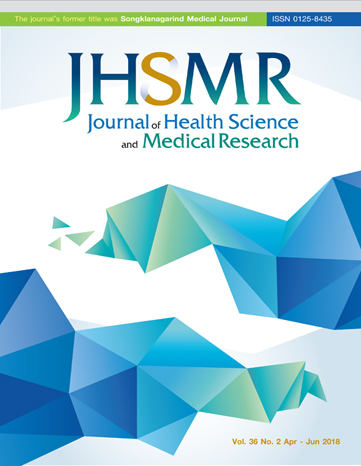Thai Adolescent Depression: Recurrence Prevention in Practice
DOI:
https://doi.org/10.31584/jhsmr.2018.36.2.8Keywords:
recurrence prevention, depression, adolescent, ThailandAbstract
This article aims to review current practice of recurrent prevention and intervention of adolescent depressive disorder in Thailand, in particular the Thai Clinical Practice Guideline of Major Depressive Disorder for General Practitioner (CPG-MDD-GP), which is now the official guideline for all depressive patients who are children, adolescents and adults in Thailand. Although this current Thai clinical guideline was developed and derived from the UK’s National Institute for Health and Care Excellence (NICE) recommendation and the American Academy of Child and Adolescent Psychiatry (AACAP) Practice Parameter, it differs from these guidelines in a number of ways. Specifically, the main tool for the primary assessment of the Thai CPG-MDD-GP is called 9Q which categorizes the severity and follow-up of depressive symptoms by health care providers in hospital setting, whereas the NICE guideline for depression in children and adolescents is mainly based on community setting and the AACAP parameter assesses patients by the direct interview method. Additionally, the Thai CPG-MDD-GP has no premise intervention for recurrence prevention of depression and lacks details regarding the importance of treatment engagement by family and community.
References
2. Chaveepojnkamjorn W, Pichainarong N, Adthasangsri V, Sativipawee P, Prasertsong C. Depression and its associated
factors among Senior High School students in Nonthaburi Province, Thailand: a cross-sectional study. JPHDC 2017;2:
224-34.
3. Post R. Transduction of psychosocial stress into the neurobiology of recurrent affective disorder. Am J Psychiatry 1992;149:999-1010.
4. Monroe S, Harkness K. Life stress, the “Kindling” hypothesis, and the recurrence of depression: considerations from a
life stress perspective. Psychol Rev 2005;112:417-45.
5. Herman K, Reinke W, Parkin J, Traylor K, Agarwal G. Childhood depression: rethinking the role of the school.
Psychol Sch 2009;46:433-46.
6. Renaud J, Brent D, Baugher M, Birmaher B, Kolko D, Bridge J. Rapid response to psychosocial treatment for adolescent depression: a two-year follow-up. J Am Acad Child Adolesc Psychiatry 1998;37:1184-90.
7. Amattayakong A. Thai mental health database [homepage on the Internet]. Nonthaburi: Department of Mental Health, Ministry of Public Health; 2017 [cited 2015 Jul 22]. Available from: http://www.dmh.go.th/abstract
8. The Excellence Center of Depressive Disorder. Clinical practice guideline of major depressive disorder for general practitioner [homepage on the Internet]. Ubon Ratchatani: Prasrimahabhodi Hospital; 2017 [cited 2015 Jul 20]. Available from: http://www.thaidepression.com
9. National Institute for Health and Care Excellence. Depression in children and young people: identification and management [homepage on the Internet]. London: NICE; 2017 [cited 2015 May 13]. Available from: http://www.nice.org.uk/guidance/cg28
10. Birmaher B, Brent D. Practice parameter for the assessment and treatment of children and adolescents with depressive disorders. J Am Acad Child Adolesc Psychiatry 2007;46:1503-26.
11. Mahidol University. Faculty of Medicine Siriraj Hospital. Department of Psychiatry. Child and adolescent psychiatric
rehabilitation program [homepage on the Internet]. Bangkok: The University; 2017 [cited 2017 Nov 13]. Available from: http://www.si.mahidol.ac.th/th/department/psychiatrics/index.asp?pp=newsD&n_id=153
12. Sanford M, Boyle M, Mccleary L, Miller J, Steele M, Duku E, et al. A pilot study of adjunctive family psychoeducation in adolescent major depression: feasibility and treatment effect. J Am Acad Child Adolesc Psychiatry 2006;45:386-95.
13. Kroenke K, Spitzer R, Williams J. The PHQ-9. J Gen Intern Med 2001;16:606-13.
14. Rohde P, Seeley J, Kaufman N, Clarke G, Stice E. Predicting time to recovery among depressed adolescents treated in two psychosocial group interventions. J Consult Clin Psychol 2006;74:80-8.
15. Birmaher B, Brent D, Kolko D, Baugher M, Bridge J, Holder D, et al. Clinical outcome after short-term psychotherapy for adolescents with major depressive disorder. Arch Gen Psychiatry 2000;57:29.
16. NHS Scotland. CAMH service tiers [homepage on the Internet]. Edinburgh: Healthcare Improvement Scotland:2017 [cited 2017 Sep 24]. Available from: http://www.icptoolkit.org/child_and_adolescent_pathways/about_icps/camh_
service_tiers.aspx
17. Lewandowski R, Acri M, Hoagwood K, Olfson M, Clarke G,Gardner W, et al. Evidence for the management of adolescent depression. Pediatrics [serial on the Internet]. 2013 Oct [cited 2017 Sep 11]; 132(4). Available from: http://pediatrics.aappublications.org/content/132/4/e996.figures-only
























